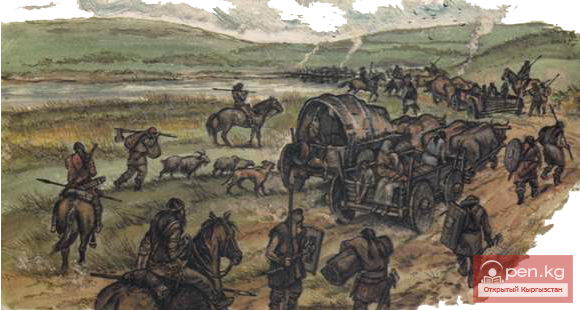NEW ASPECTS IN THE CULTURE OF EARLY NOMADS OF THE TIEN SHAN
On the territory of Inner Tien Shan, monuments from all ancient epochs are known to date: Stone Age, Bronze Age, Early Iron Age, and the Medieval period.
As is known, the beginning of the documentation of monuments in this region was laid in the second half of the 19th century by the works of Russian scholars and local historians, such as Ch.Ch. Valikhanov, N.A. Severcev, V.V. Bartold, A.M. Fetisov, N.N. Pantusov, and others. They surveyed the settlement of Koshoy-Korgon, the caravanserai of Tash-Rabat, the fortress of Shirdakbek, and burial grounds in the basins of the rivers Kara-Koyun, Naryn, Kochkorka, and others. However, these were isolated and undated monuments according to the researchers.
The number of antiquities increased slightly in the first two decades of Soviet power. Inner Tien Shan, with its thousands of monuments of nomadic and settled populations, remained unknown to archaeologists. The pioneer in studying the ancient monuments of this region was A.N. Bernshtam. His first visit to Tien Shan took place in 1940, after surveying the Issyk-Kul basin. A brief trip to the Kochkor Valley allowed him to discover a number of burial grounds, survey a settlement in the area of Kochkor-Ata, and the domes of the 3rd-18th centuries in the Kyk-Choro area, outlining the prospects for further study of Tien Shan.
The expansion of A.N. Bernshtam's research in Tien Shan relates to the years 1944-1946 and especially to 1949. During this time, reconnaissance surveys were conducted in all areas of Inner Tien Shan, except for hard-to-reach places.
Interestingly, he visited locations that, in some cases, had not yet been explored by archaeologists. In 1944-1945, for the first time not only for Inner Tien Shan but also for Kyrgyzstan, monuments of the Stone Age were discovered. Thus, in a cave near the Torugart Pass, A.N. Bernshtam managed to find stone tools of primitive man. At that time, he also gathered information about the caves in the Atbashinsky ridge and the Naryn-Tuu mountains.
The discovery of Bronze Age burials in the high-altitude Arpa Valley was truly a scientific sensation. Before this, only random finds of Bronze Age tool caches were known in Kyrgyzstan, such as those at Issyk-Kul and in the Chui Valley, as well as shepherds' camps in the areas of Dzhailma and Kainda. However, the majority of monuments in Inner Tien Shan consisted of burial mounds of early nomads. A.N. Bernshtam discovered them at the Torugart Pass, in the basins of the rivers Ak-Sai and Arpa, in the Atbashin Valley, in the basin of the Naryn River and its tributaries, in the Kochkor and Jumgal valleys. About 30 burial mounds from the Saka-Usun period were excavated in the burial grounds of Alamyshyk, Dzhargetal, Acha-Tyube, Dzhkarkim-bai, Ozgorush, and others.
The materials obtained from the burials, combined with extensive observations, allowed A.N. Bernshtam to provide a historical periodization of the monuments of early nomads of Tien Shan.
Thus, the early period, 2nd-5th centuries BC, included the burials of the Alamyshyk, Dzhargetal, and Kurchin burial grounds. This group of monuments was united by the following characteristics: the nature of the cromlech-like mound mainly oriented to the west of the buried; the presence of a stone "pillow" under the head; the absence of iron artifacts and the presence of bronze items. However, in these burials, some differences in the position of the corpses can be observed - on the back or curled on the side and with different orientations.
The next period - 5th-3rd centuries BC - was named the Issedonian or Pre-Usun period. A number of burials from the same burial grounds, as well as from the Dzharkimbai burial ground, were included here, preserving stone boxes and cromlechs, with very poor inventory, mainly containing rough pottery with a hemispherical bottom. There is no unity in the orientation of the buried.
For the 2nd century BC, Usun-Yushzhiy burials were distinguished, covered with wooden planks or stone slabs (burial grounds of Alamyshyk, Dzhargetal, etc.), and in wooden structures of the log type (burial grounds of Sokolovka and Dzherges at Issyk-Kul).
The 1st-4th centuries AD were named the Hunnic period, which included burials in catacomb and undercut graves of the Kyzart, Kurchin, Alamyshyk, and Burmachap burial grounds.
This historical periodization of the monuments of early nomads of Tien Shan then formed the basis for the general classification of all known monuments of Semirechye and Tien Shan at that time, which has not lost its fundamental significance to this day.
History and Archaeology of Ancient Tien Shan














































